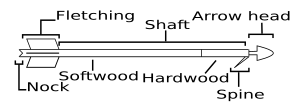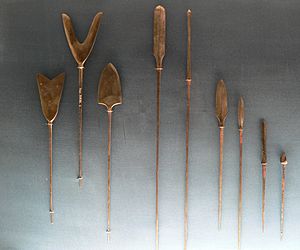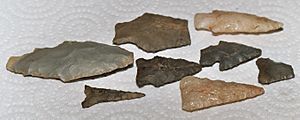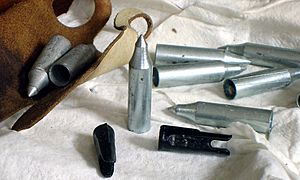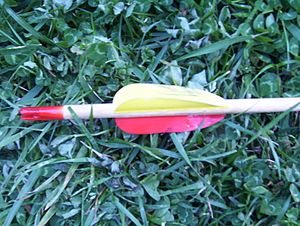Arrow facts for kids
An arrow is a shape used to point to something. Arrows look like this: -->. "Double-headed" arrows look like this: <-->.
An arrow is a projectile fired with a bow. A bow and arrow is a weapon used before medieval times and later. Early Native Americans used bows and arrows for hunting and for defense. Nearly all cultures have used the bow and arrow in their past. Arrows have a sharp point at one end and usually a flight at the other end. The flight is usually made of feathers and helps the arrow go through the air straight.
History
The oldest evidence of stone-tipped projectiles, which may or may not have been propelled by a bow (c.f. atlatl), dating to c. 64,000 years ago, were found in Sibudu Cave, current South Africa. The oldest evidence of the use of bows to shoot arrows dates to about 10,000 years ago; it is based on pinewood arrows found in the Ahrensburg valley north of Hamburg. They had shallow grooves on the base, indicating that they were shot from a bow. The oldest bow so far recovered is about 8,000 years old, found in the Holmegård swamp in Denmark. Archery seems to have arrived in the Americas with the Arctic small tool tradition, about 4,500 years ago.
Size
Arrow sizes vary greatly across cultures, ranging from eighteen inches to five feet (45 cm to 150 cm). However, most modern arrows are 75 centimetres (30 in) to 96 centimetres (38 in); most war arrows from an English ship sunk in 1545 were 76 centimetres (30 in). Very short arrows have been used, shot through a guide attached either to the bow (an "overdraw") or to the archer's wrist (the Turkish "siper"). These may fly farther than heavier arrows, and an enemy without suitable equipment may find himself unable to return them.
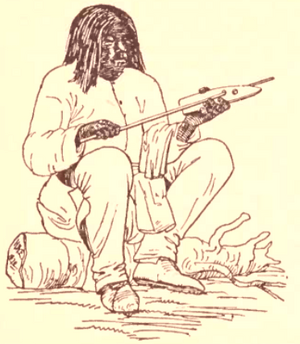
Shaft
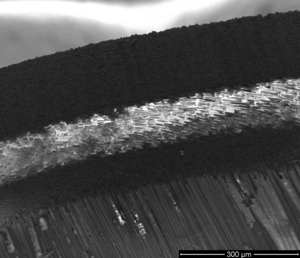
The shaft is the primary structural element of the arrow, to which the other components are attached. Traditional arrow shafts are made from strong, lightweight wood, bamboo or reeds, while modern shafts may be made from aluminium, carbon fibre reinforced plastic, or a combination of materials. Such shafts are typically made from an aluminium core wrapped with a carbon fibre outer. A traditional premium material is Port Orford Cedar.
The stiffness of the shaft is known as its spine, referring to how little the shaft bends when compressed. Hence, an arrow which bends less is said to have more spine. In order to strike consistently, a group of arrows must be similarly spined. "Center-shot" bows, in which the arrow passes through the central vertical axis of the bow riser, may obtain consistent results from arrows with a wide range of spines. However, most traditional bows are not center-shot and the arrow has to deflect around the handle in the archer's paradox; such bows tend to give most consistent results with a narrower range of arrow spine that allows the arrow to deflect correctly around the bow. Higher draw-weight bows will generally require stiffer arrows, with more spine (less flexibility) to give the correct amount of flex when shot.
GPI rating
The weight of an arrow shaft can be expressed in GPI (Grains Per Inch). The length of a shaft in inches multiplied by its GPI rating gives the weight of the shaft in grains. For example, a shaft that is 30 inches long and has a GPI of 9.5 weighs 285 grains, or about 18 grams. This does not include the other elements of a finished arrow, so a complete arrow will be heavier than the shaft alone.
Footed arrows
Sometimes a shaft will be made of two different types of wood fastened together, resulting in what is known as a footed arrow. Known by some as the finest of wood arrows, footed arrows were used both by early Europeans and Native Americans. Footed arrows will typically consist of a short length of hardwood near the head of the arrow, with the remainder of the shaft consisting of softwood. By reinforcing the area most likely to break, the arrow is more likely to survive impact, while maintaining overall flexibility and lighter weight.
Arrowhead
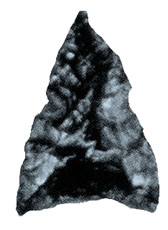
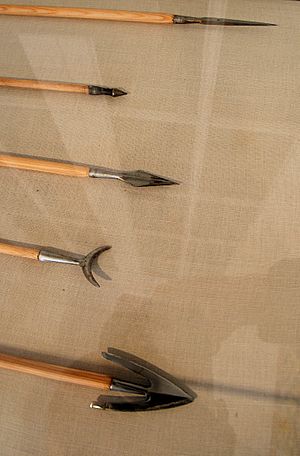
The arrowhead or projectile point is the primary functional part of the arrow, and plays the largest role in determining its purpose. Some arrows may simply use a sharpened tip of the solid shaft, but it is far more common for separate arrowheads to be made, usually from metal, horn, or some other hard material. Arrowheads are usually separated by function:
- Bodkin points
These are short, rigid points with a small cross-section. They were made of unhardened iron and may have been used for better or longer flight, or for cheaper production. It has been mistakenly suggested that the bodkin came into its own as a means of penetrating armour, but research has found no hardened bodkin points, so it is likely that it was first designed either to extend range or as a cheaper and simpler alternative to the broadhead. In a modern test, a direct hit from a hard steel bodkin point penetrated Damascus chain armour. However, archery was not effective against plate armour, which became available to knights of fairly modest means by the late 14th century.
- Blunts are unsharpened arrowheads occasionally used for types of target shooting, for shooting at stumps or other targets of opportunity, or hunting small game when the goal is to stun the target without penetration. Blunts are commonly made of metal or hard rubber. They may stun, and occasionally, the arrow shaft may penetrate the head and the target; safety is still important with blunt arrows.
- Judo points have spring wires extending sideways from the tip. These catch on grass and debris to prevent the arrow from being lost in the vegetation. Used for practice and for small game.
- Broadheads were used for war and are still used for hunting. Medieval broadheads could be made from steel, sometimes with hardened edges. They usually have two to four sharp blades that cause massive bleeding in the victim. Their function is to deliver a wide cutting edge so as to kill as quickly as possible by cleanly cutting major blood vessels, and cause further trauma on removal. They are expensive, damage most targets, and are usually not used for practice.
There are two main types of broadheads used by hunters: The fixed-blade and the mechanical types. While the fixed-blade broadhead keeps its blades rigid and unmovable on the broadhead at all times, the mechanical broadhead deploys its blades upon contact with the target, its blades swinging out to wound the target. The mechanical head flies better because it is more streamlined, but has less penetration as it uses some of the kinetic energy in the arrow to deploy its blades.
- Field tips are similar to target points and have a distinct shoulder, so that missed outdoor shots do not become as stuck in obstacles such as tree stumps. They are also used for shooting practice by hunters, by offering similar flight characteristics and weights as broadheads, without getting lodged in target materials and causing excessive damage upon removal.
- Target points are bullet-shaped with a conical point, designed to penetrate target butts easily without causing excessive damage to them.
- Safety arrows are designed to be used in various forms of reenactment combat, to reduce the risk when shot at people. These arrows may have heads that are very wide or padded. In combination with bows of restricted draw weight and draw length, these heads may reduce to acceptable levels the risks of shooting arrows at suitably armoured people. The parameters will vary depending on the specific rules being used and on the levels of risk felt acceptable to the participants. For instance, SCA combat rules require a padded head at least 11⁄4" in diameter, with bows not exceeding 28 inches (710 mm) and 50 lb (23 kg) of draw for use against well-armoured individuals.
Arrowheads may be attached to the shaft with a cap, a socketed tang, or inserted into a split in the shaft and held by a process called hafting. Points attached with caps are simply slid snugly over the end of the shaft, or may be held on with hot glue. Split-shaft construction involves splitting the arrow shaft lengthwise, inserting the arrowhead, and securing it using a ferrule, sinew, or wire.
Fletchings

Fletchings are found at the back of the arrow and act as airfoils to provide a small amount of force used to stabilize the flight of the arrow. They are designed to keep the arrow pointed in the direction of travel by strongly damping down any tendency to pitch or yaw. Some cultures, for example most in New Guinea, did not use fletching on their arrows. Also, arrows without fletching (called bare shaft) are used for training purposes, because they make certain errors by the archer more visible.
Fletchings are traditionally made from feathers (often from a goose or turkey) bound to the arrow's shaft, but are now often made of plastic (known as "vanes"). Historically, some arrows used for the proofing of armour used copper vanes. Flight archers may use razor blades for fletching, in order to reduce air resistance. With conventional three-feather fletching, one feather, called the "cock" feather, is at a right angle to the nock, and is normally nocked so that it will not contact the bow when the arrow is shot. Four-feather fletching is usually symmetrical and there is no preferred orientation for the nock; this makes nocking the arrow slightly easier.
Natural feathers are usually prepared by splitting and sanding the quill before gluing. Further, the feather may be trimmed to shape, die-cut or burned by a hot electrically-heated wire. It's crucial that all the feathers of an arrow have the same drag, so manual trimming is rarely used by modern fletchers. The burning-wire method is popular because different shapes are possible by bending the wire, and the fletching can be symmetrically trimmed after gluing by rotating the arrow on a fixture.
Some fletchings are dyed. Two-toned fletchings usually make each fletching from two feathers knit together. The front fletching is often camouflaged, and the rear fletching bright so that the archer can easily track the arrow.
Artisans who make arrows by hand are known as "fletchers," a word related to the French word for arrow, flèche. This is the same derivation as the verb "fletch," meaning to provide an arrow with its feathers. Glue and thread are the traditional methods of attaching fletchings. A "fletching jig" is often used in modern times, to hold the fletchings in exactly the right orientation on the shaft while the glue hardens.
Whenever natural fletching is used, the feathers on any one arrow must come from the same wing of the bird. The most common being the right-wing flight feathers of turkeys. The slight cupping of natural feathers requires them to be fletched with a right-twist for right wing, a left-twist for left wing. This rotation, through a combination of gyroscopic stabilization and increased drag on the rear of the arrow, helps the arrow to fly straight away. Artificial helical fletchings have the same effect. Most arrows will have three fletches, but some have four or even more. Fletchings generally range from two to six inches (152 mm) in length; flight arrows intended to travel the maximum possible distance typically have very low fletching, while hunting arrows with broadheads require long and high fletching to stabilize them against the aerodynamic effect of the head. Fletchings may also be cut in different ways, the two most common being parabolic (i.e. a smooth curved shape) and shield (i.e. shaped as one-half of a very narrow shield) cut.
In modern archery with screw-in points, right-hand rotation is generally preferred as it makes the points self-tighten. In traditional archery, some archers prefer a left rotation because it gets the hard (and sharp) quill of the feather farther away from the arrow-shelf and the shooter's hand.
A flu-flu is a form of fletching, normally made by using long sections of full length feathers taken from a turkey, in most cases six or more sections are used rather than the traditional three. Alternatively two long feathers can be spiraled around the end of the arrow shaft. The extra fletching generates more drag and slows the arrow down rapidly after a short distance, about 30 m or so .
Flu-Flu arrows are often used for hunting birds, or for children's archery, and can also be used to play Flu-Flu Golf.
Images for kids
-
Warring States bronze arrowheads
See also
 In Spanish: Flecha para niños
In Spanish: Flecha para niños



